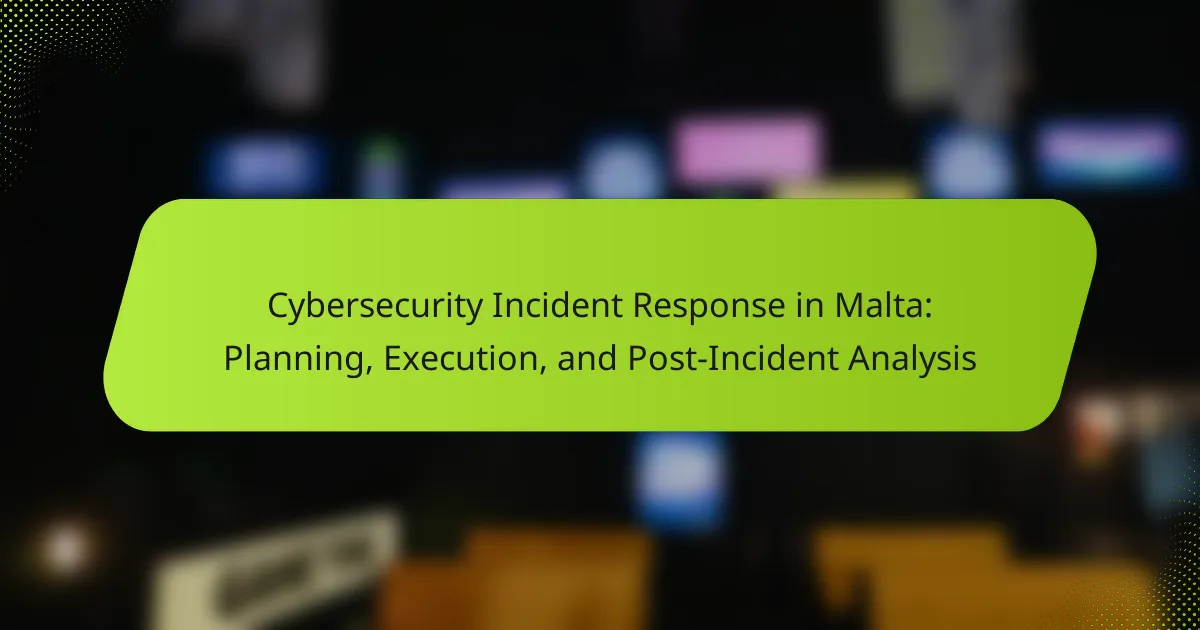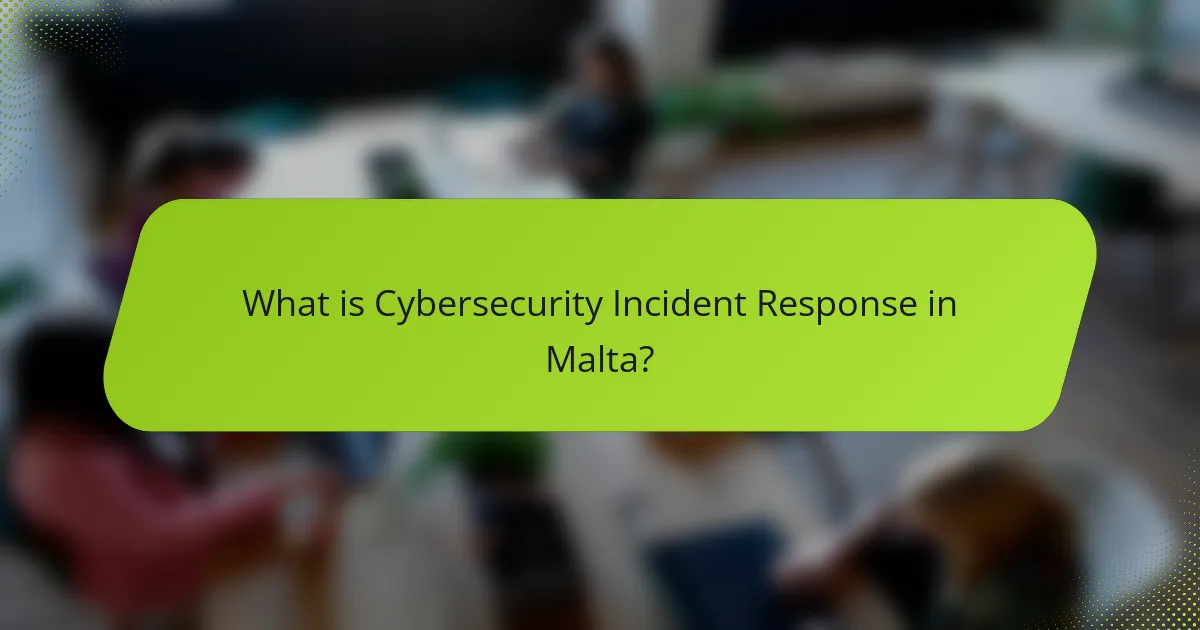
What is Cybersecurity Incident Response in Malta?
Cybersecurity Incident Response in Malta refers to the structured approach for managing and mitigating cybersecurity incidents. This process includes preparation, detection, analysis, containment, eradication, and recovery from security breaches. Organizations in Malta follow established frameworks, such as the NIST Cybersecurity Framework, to guide their response efforts. The aim is to minimize damage and restore normal operations as quickly as possible. Malta’s cybersecurity strategy emphasizes collaboration between public and private sectors. This collaboration enhances the effectiveness of incident response through shared resources and expertise. The Maltese government also supports initiatives to improve national cybersecurity resilience. These initiatives include training programs and awareness campaigns for organizations across various sectors.
How is Cybersecurity Incident Response defined in the context of Malta?
Cybersecurity Incident Response in Malta is defined as a structured approach to managing and mitigating cybersecurity incidents. This process includes preparation, detection, analysis, containment, eradication, recovery, and post-incident review. The framework aligns with the European Union’s cybersecurity regulations and the National Cyber Security Strategy of Malta. It emphasizes collaboration between public and private sectors for effective incident management. Malta’s response strategy also incorporates guidelines from the Computer Security Incident Response Team (CSIRT) and the European Union Agency for Cybersecurity (ENISA). These measures ensure timely communication and coordination during incidents, enhancing overall cybersecurity resilience.
What are the key components of Cybersecurity Incident Response?
The key components of Cybersecurity Incident Response are preparation, detection, analysis, containment, eradication, recovery, and post-incident review. Preparation involves establishing policies and procedures for incident response. Detection is identifying potential security incidents through monitoring and alerts. Analysis assesses the incident’s nature and impact. Containment limits the damage from the incident. Eradication involves removing the threat from the environment. Recovery restores affected systems to normal operations. Post-incident review evaluates the response effectiveness and identifies areas for improvement. These components work together to ensure a comprehensive response to cybersecurity incidents.
How does the legal framework in Malta influence Cybersecurity Incident Response?
The legal framework in Malta significantly influences Cybersecurity Incident Response by establishing regulatory requirements and guidelines. Malta’s Data Protection Act mandates organizations to report data breaches within 72 hours. This requirement ensures timely responses and mitigates potential damage from incidents. Additionally, the Cybersecurity Act outlines responsibilities for both public and private entities in managing cybersecurity threats. Compliance with these laws fosters a structured approach to incident response. The framework also promotes collaboration between government agencies and businesses, enhancing overall cybersecurity resilience. Furthermore, adherence to the EU General Data Protection Regulation (GDPR) reinforces the importance of protecting personal data during incident management. These legal stipulations create a proactive environment for addressing cybersecurity incidents effectively.
Why is Cybersecurity Incident Response important for organizations in Malta?
Cybersecurity Incident Response is crucial for organizations in Malta to mitigate the impact of cyber threats. It enables organizations to quickly identify, respond to, and recover from security incidents. This is essential in a digital landscape where cyberattacks are increasingly sophisticated and frequent. According to the European Union Agency for Cybersecurity (ENISA), 70% of organizations experience a cyber incident annually. Effective incident response minimizes downtime and financial losses. It also helps maintain customer trust and compliance with regulations. In Malta, where businesses are becoming more digital, the importance of a robust incident response strategy is amplified. Organizations that invest in incident response are better prepared to handle potential breaches effectively.
What are the potential risks of inadequate Cybersecurity Incident Response?
Inadequate Cybersecurity Incident Response can lead to significant risks for organizations. These risks include data breaches, which can result in the loss of sensitive information. Financial losses often occur due to recovery costs and potential fines. Reputational damage can undermine customer trust, affecting long-term business relationships. Regulatory penalties may arise if compliance requirements are not met. Operational disruptions can hinder business continuity, impacting productivity. Additionally, inadequate response can allow attackers to exploit vulnerabilities, leading to further incidents. According to a 2020 report by IBM, the average cost of a data breach is $3.86 million, highlighting the financial impact of poor incident response.
How can effective Cybersecurity Incident Response protect organizational assets?
Effective Cybersecurity Incident Response protects organizational assets by minimizing damage during a security breach. It enables rapid identification of threats, allowing for swift containment of incidents. This quick action reduces the potential for data loss and financial impact. Additionally, it helps maintain business continuity by restoring operations promptly. Incident response plans also include communication protocols, which preserve stakeholder trust. Regular training and simulations enhance the team’s preparedness for real incidents. According to the Ponemon Institute, organizations with an incident response plan save an average of $2 million per data breach. This demonstrates the financial benefits of effective incident response in safeguarding assets.
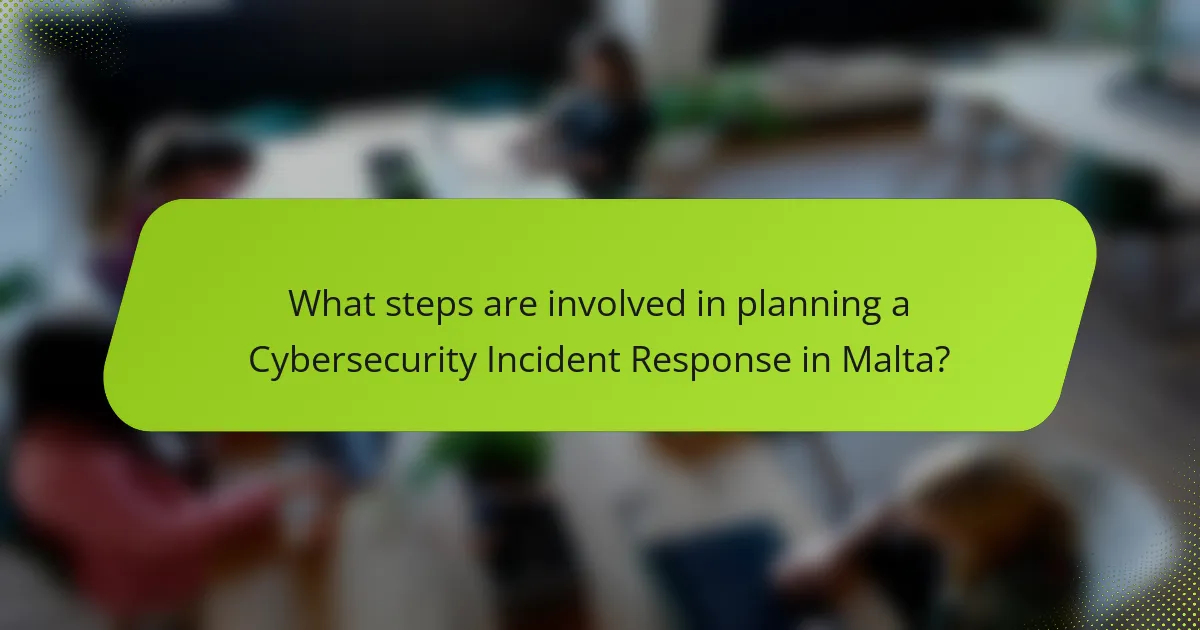
What steps are involved in planning a Cybersecurity Incident Response in Malta?
The steps involved in planning a Cybersecurity Incident Response in Malta include establishing an incident response policy, forming an incident response team, conducting risk assessments, developing an incident response plan, and implementing training and awareness programs.
The incident response policy outlines the organization’s approach to managing cybersecurity incidents. The incident response team is responsible for executing the response plan and coordinating efforts during an incident. Risk assessments identify potential threats and vulnerabilities specific to the organization. The incident response plan details procedures for detection, containment, eradication, recovery, and post-incident analysis. Training and awareness programs ensure that staff are prepared to recognize and respond to incidents effectively.
How do organizations in Malta develop an Incident Response Plan?
Organizations in Malta develop an Incident Response Plan by following structured methodologies tailored to their specific needs. They begin by assessing their cybersecurity risks and identifying potential threats. This assessment guides them in defining clear roles and responsibilities within the response team.
Next, organizations establish a communication plan to ensure effective information flow during incidents. They also create detailed procedures for detecting, responding to, and recovering from cybersecurity incidents. Regular training and simulation exercises are conducted to prepare the team for real-world scenarios.
Additionally, organizations review and update their plans regularly to adapt to evolving threats. Compliance with local regulations and guidance from the Malta Cyber Security Agency further informs their planning process. This systematic approach ensures that organizations in Malta are well-prepared to handle cybersecurity incidents effectively.
What are the essential elements of an effective Incident Response Plan?
An effective Incident Response Plan (IRP) includes several essential elements. These elements are preparation, identification, containment, eradication, recovery, and lessons learned. Preparation involves establishing and training an incident response team. Identification focuses on detecting and classifying incidents accurately. Containment aims to limit the impact of an incident on the organization. Eradication involves removing the cause of the incident from the environment. Recovery includes restoring systems and operations to normal. Finally, lessons learned involves analyzing the incident to improve future responses. Each of these elements contributes to a comprehensive approach to managing cybersecurity incidents effectively.
How can organizations assess their readiness for incidents?
Organizations can assess their readiness for incidents by conducting regular risk assessments and audits. These evaluations identify potential vulnerabilities and gaps in current security measures. Organizations should implement tabletop exercises to simulate incident scenarios. This practice helps teams understand their roles and improve response strategies. Regular training sessions for staff enhance awareness and preparedness. Additionally, organizations can review past incidents to learn from previous mistakes. Maintaining an updated incident response plan is crucial for effective readiness. Metrics and key performance indicators can measure response effectiveness over time.
What roles and responsibilities are critical in the planning phase?
The critical roles and responsibilities in the planning phase of cybersecurity incident response include the incident response manager, security analysts, and IT support staff. The incident response manager coordinates the overall response strategy. This role ensures that all team members understand their tasks and responsibilities. Security analysts assess potential threats and develop response plans. They analyze vulnerabilities and propose mitigation strategies. IT support staff provide technical assistance and maintain system integrity during incidents. Their role is vital for implementing security measures and ensuring system functionality. These roles collectively enhance the organization’s preparedness for cybersecurity incidents.
Who should be part of an Incident Response Team?
An Incident Response Team should include cybersecurity analysts, incident responders, and IT support staff. Cybersecurity analysts identify and assess threats. Incident responders manage and mitigate incidents. IT support staff provide technical assistance and resources. Additionally, legal advisors ensure compliance with regulations. Communication specialists handle internal and external messaging. Management representatives oversee decision-making and resource allocation. Each role is essential for effective incident management and recovery.
What training is necessary for the Incident Response Team in Malta?
The training necessary for the Incident Response Team in Malta includes cybersecurity fundamentals, incident handling, and threat analysis. Team members must understand network security protocols and malware analysis techniques. Training should also cover forensic investigation methods and legal compliance regarding data breaches. Regular simulations and tabletop exercises are essential for practical experience. Additionally, familiarity with relevant tools and technologies is critical. Continuous education on emerging threats and vulnerabilities is necessary to stay effective. This structured training ensures the team can respond efficiently to incidents.
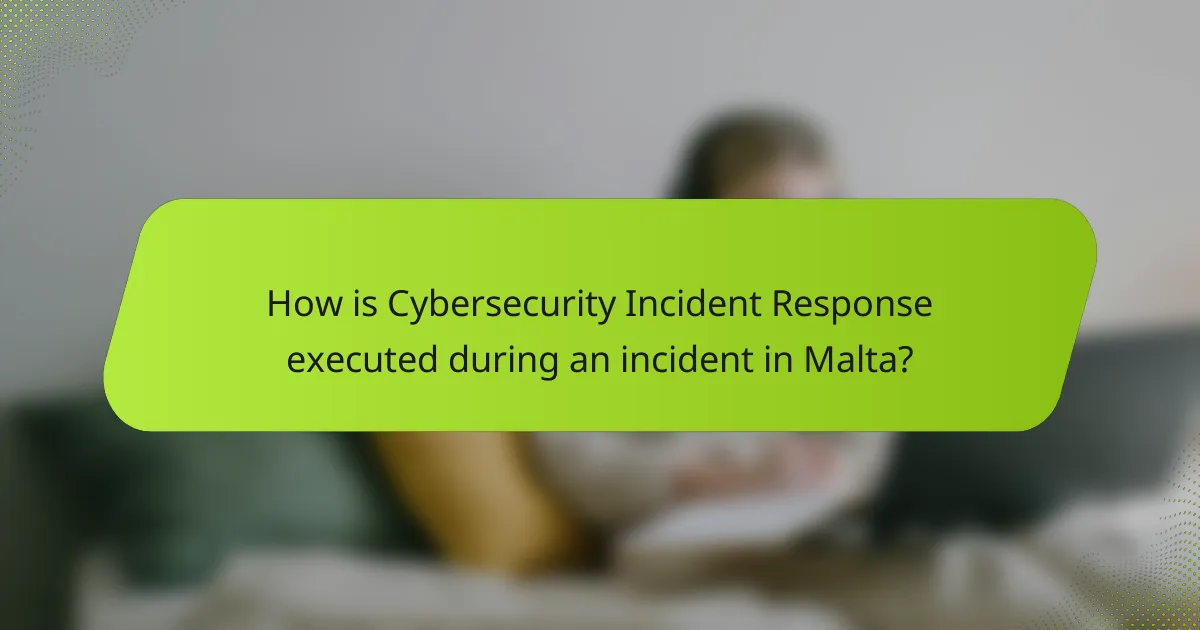
How is Cybersecurity Incident Response executed during an incident in Malta?
Cybersecurity Incident Response in Malta is executed through a structured process involving several key steps. The first step is detection, where incidents are identified through monitoring tools and alerts. Once detected, the incident is assessed to determine its severity and potential impact. The response team is then activated to contain the incident and prevent further damage.
After containment, the team works on eradication, removing the root cause of the incident. Recovery follows, restoring systems and services to normal operation while ensuring that vulnerabilities are addressed. Finally, a post-incident analysis is conducted to evaluate the response and improve future incident handling.
This structured approach aligns with best practices in cybersecurity and is essential for effective incident management in Malta.
What are the key phases of execution in Cybersecurity Incident Response?
The key phases of execution in Cybersecurity Incident Response are preparation, detection, analysis, containment, eradication, recovery, and post-incident review. Preparation involves establishing an incident response plan and training the response team. Detection focuses on identifying potential security incidents through monitoring tools. Analysis assesses the nature and impact of the incident. Containment aims to limit the damage and prevent further compromise. Eradication removes the cause of the incident from the environment. Recovery restores affected systems and services to normal operation. Post-incident review evaluates the response process to improve future incident handling. These phases ensure a structured approach to managing cybersecurity incidents effectively.
How should organizations detect and analyze cybersecurity incidents?
Organizations should implement a multi-layered approach to detect and analyze cybersecurity incidents. This includes deploying intrusion detection systems (IDS) to monitor network traffic for suspicious activities. Regularly updating and patching software is crucial to minimize vulnerabilities.
Organizations should also conduct security audits and vulnerability assessments to identify potential weaknesses. Employee training on recognizing phishing attempts and social engineering is vital for early detection.
Utilizing security information and event management (SIEM) systems can help aggregate and analyze security data in real-time. Establishing an incident response team ensures timely investigation and response to detected incidents.
According to a 2021 report by IBM, organizations with an incident response plan can reduce the cost of a data breach by an average of $2 million. This highlights the importance of structured detection and analysis processes in mitigating cybersecurity risks.
What actions should be taken to contain and eradicate threats?
Identify the threat and assess its impact. Containment actions should include isolating affected systems to prevent further damage. Eradication involves removing malicious software and closing vulnerabilities. Implement patches and updates to strengthen security. Conduct a thorough investigation to understand the attack vector. Document all actions taken for future reference. Engage with law enforcement if necessary for serious breaches. Regularly review and update incident response plans based on lessons learned.
How do communication strategies impact incident execution?
Effective communication strategies significantly enhance incident execution in cybersecurity. Clear communication ensures that all team members understand their roles and responsibilities during an incident. It facilitates timely information sharing, which is critical for swift decision-making. For example, a study by the National Institute of Standards and Technology emphasizes that communication protocols can reduce response times by up to 30%. Additionally, effective communication mitigates confusion, allowing for coordinated efforts in managing the incident. This coordination is essential for minimizing damage and restoring systems efficiently. Overall, robust communication strategies are integral to successful incident execution in cybersecurity.
What internal and external communication should be established during an incident?
Internal communication during an incident should include immediate notifications to key stakeholders. This includes IT teams, management, and security personnel. Clear directives should be issued to ensure a coordinated response. Regular updates should be shared to maintain situational awareness among all team members.
External communication must involve informing relevant authorities and affected parties. This includes law enforcement and regulatory bodies when necessary. Public communication should be managed to provide accurate information to customers and the media. Transparency is crucial to maintain trust and manage reputational risk.
Establishing communication channels ensures timely and effective information flow. This approach minimizes confusion and enhances the overall incident response. Clear communication protocols are essential for compliance with regulations, such as GDPR, which mandates prompt notification of data breaches.
How can organizations ensure transparency while managing incidents?
Organizations can ensure transparency while managing incidents by implementing clear communication protocols. They should establish guidelines for timely updates to stakeholders. Regular briefings can keep all parties informed about incident status. Documenting decisions and actions taken during the incident is essential. This creates an accurate record for review. Sharing information about the incident’s impact fosters trust. Utilizing a dedicated incident response team can streamline communication efforts. Engaging with external parties, such as regulatory bodies, enhances accountability. Studies show that transparent organizations experience better stakeholder confidence during crises.
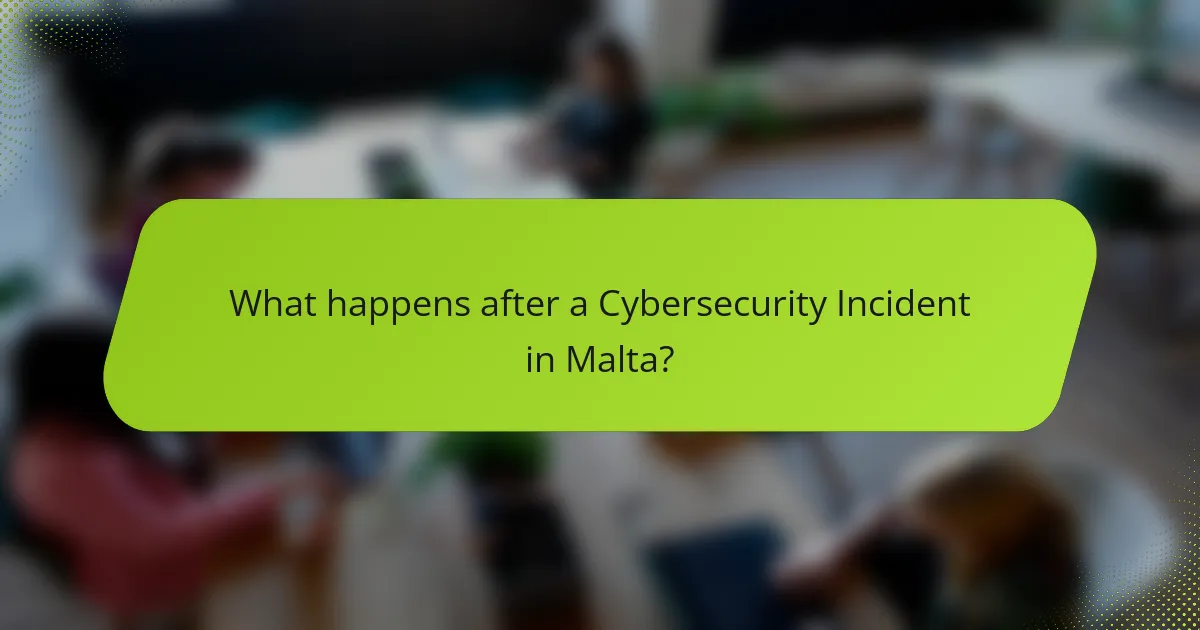
What happens after a Cybersecurity Incident in Malta?
After a cybersecurity incident in Malta, organizations must initiate a response plan. This involves assessing the incident’s impact and scope. They should contain the breach to prevent further damage. Affected systems must be analyzed to understand vulnerabilities. Communication with stakeholders is crucial during this phase. Legal obligations may require reporting to authorities. Recovery efforts focus on restoring systems and data. A thorough post-incident review helps improve future response strategies. These steps ensure compliance with Malta’s cybersecurity regulations and enhance overall security posture.
What is the importance of post-incident analysis?
Post-incident analysis is crucial for improving cybersecurity measures. It helps organizations identify vulnerabilities that were exploited during an incident. This analysis allows teams to understand the attack vectors used by cybercriminals. By examining the response to the incident, organizations can refine their incident response plans. Additionally, post-incident analysis aids in compliance with regulatory requirements. It provides documented evidence of the organization’s response efforts. This documentation can be vital for audits and reviews. Moreover, lessons learned can be shared across teams to foster a culture of continuous improvement. Overall, post-incident analysis strengthens an organization’s resilience against future threats.
How can organizations conduct a thorough post-incident review?
Organizations can conduct a thorough post-incident review by following a structured process. First, they should gather all relevant data from the incident. This includes logs, alerts, and any other documentation. Next, they need to assemble a review team comprising key stakeholders. This team should include IT staff, management, and any involved third parties.
The team should then analyze the collected data to identify what happened during the incident. They should assess the effectiveness of the response and identify any gaps in the incident management process. After the analysis, organizations must document the findings in a detailed report. This report should outline lessons learned and recommendations for improvement.
Finally, organizations should implement the recommended changes to prevent future incidents. Regular follow-ups on the implementation of these recommendations are essential. Research shows that organizations conducting thorough post-incident reviews significantly reduce the likelihood of recurrence.
What lessons can be learned from analyzing incidents?
Analyzing incidents reveals critical lessons for improving cybersecurity. It helps identify vulnerabilities that were exploited during the incident. Understanding these weaknesses allows organizations to strengthen their defenses. Incident analysis also highlights the effectiveness of response strategies. This evaluation informs better preparedness for future incidents. Additionally, learning from past mistakes fosters a culture of continuous improvement. Data from the Verizon 2021 Data Breach Investigations Report shows that 85% of breaches involved human error. This underscores the need for targeted training and awareness programs.
How can organizations improve their Cybersecurity Incident Response over time?
Organizations can improve their Cybersecurity Incident Response over time by implementing continuous training and updating response plans. Regularly conducting simulations enhances team readiness. Analyzing past incidents provides valuable insights for future improvements. Utilizing threat intelligence helps organizations stay ahead of emerging threats. Investing in advanced detection tools can expedite incident identification. Establishing clear communication protocols ensures effective coordination during incidents. Collaborating with external cybersecurity experts can provide fresh perspectives and strategies. Lastly, regularly reviewing and updating policies keeps the organization aligned with evolving best practices.
What best practices should be adopted for continuous improvement?
Adopting best practices for continuous improvement in cybersecurity incident response involves regular training, systematic evaluation, and feedback integration. Regular training ensures that team members stay updated on the latest threats and response techniques. Systematic evaluation of incident response plans after each incident identifies weaknesses and areas for enhancement. Feedback integration from all stakeholders, including technical teams and management, fosters a culture of open communication. Utilizing metrics to measure response times and effectiveness provides clear data for assessing improvements. Conducting post-incident reviews helps to understand what worked and what did not. Documenting lessons learned ensures that knowledge is preserved for future reference. Implementing these practices leads to a more resilient cybersecurity posture.
How can organizations leverage incident data for future preparedness?
Organizations can leverage incident data for future preparedness by analyzing past incidents to identify trends and vulnerabilities. This analysis helps in understanding the nature and frequency of attacks. Organizations can then prioritize their resources based on the most common threats. Implementing lessons learned from past incidents enhances response strategies. Regular training and updates to incident response plans based on this data improve overall resilience. Research shows that organizations that utilize incident data reduce recovery time by up to 30%. This proactive approach fosters a culture of continuous improvement in cybersecurity practices.
What practical tips can organizations in Malta follow for effective Cybersecurity Incident Response?
Organizations in Malta can enhance their Cybersecurity Incident Response by implementing several practical tips. Firstly, they should establish a clear incident response plan. This plan must outline roles, responsibilities, and procedures for responding to incidents. Secondly, regular training and simulations for staff are essential. This ensures that employees are familiar with the protocols and can act swiftly during an incident. Thirdly, organizations should maintain updated contact information for all stakeholders involved in incident response. This includes internal teams and external partners such as law enforcement.
Moreover, effective communication strategies must be developed. Clear communication helps to manage the situation and keeps stakeholders informed. Organizations should also invest in cybersecurity tools for monitoring and detection. These tools can provide early warnings of potential incidents. Finally, after an incident, conducting a thorough post-incident analysis is crucial. This analysis helps identify weaknesses and improve future responses. By following these tips, organizations in Malta can significantly improve their cybersecurity incident response capabilities.
How can organizations ensure their Incident Response Plans are up-to-date?
Organizations can ensure their Incident Response Plans are up-to-date by conducting regular reviews and updates. They should schedule these reviews at least annually or after significant incidents. Involving relevant stakeholders during these reviews enhances the plan’s effectiveness. Training staff on the latest procedures is also crucial. This keeps everyone informed about their roles in an incident. Additionally, organizations should incorporate lessons learned from previous incidents into the plan. Monitoring emerging threats and adjusting the plan accordingly is essential. Finally, testing the plan through simulations or tabletop exercises can reveal gaps and areas for improvement. Regular updates and training ensure the plan remains relevant and effective.
What are the common pitfalls to avoid in Cybersecurity Incident Response?
Common pitfalls to avoid in Cybersecurity Incident Response include lack of preparation, inadequate communication, and failure to learn from incidents. Organizations often underestimate the importance of a well-documented incident response plan. Without preparation, teams may struggle to respond effectively during a crisis. Inadequate communication can lead to confusion and delays in response efforts. Additionally, failing to analyze past incidents prevents organizations from improving their response strategies. Research shows that 70% of organizations experience the same incidents repeatedly due to this oversight. Regular training and updates to the response plan are crucial for success.
Cybersecurity Incident Response in Malta encompasses the structured processes for managing and mitigating cybersecurity incidents, including preparation, detection, analysis, containment, eradication, recovery, and post-incident review. The article details the significance of adhering to established frameworks, such as the NIST Cybersecurity Framework, and highlights the collaboration between public and private sectors to enhance incident response effectiveness. Key components of incident response, the influence of Malta’s legal framework, and the importance of post-incident analysis are also discussed, providing organizations with practical tips for improving their cybersecurity posture and ensuring readiness against potential threats.
